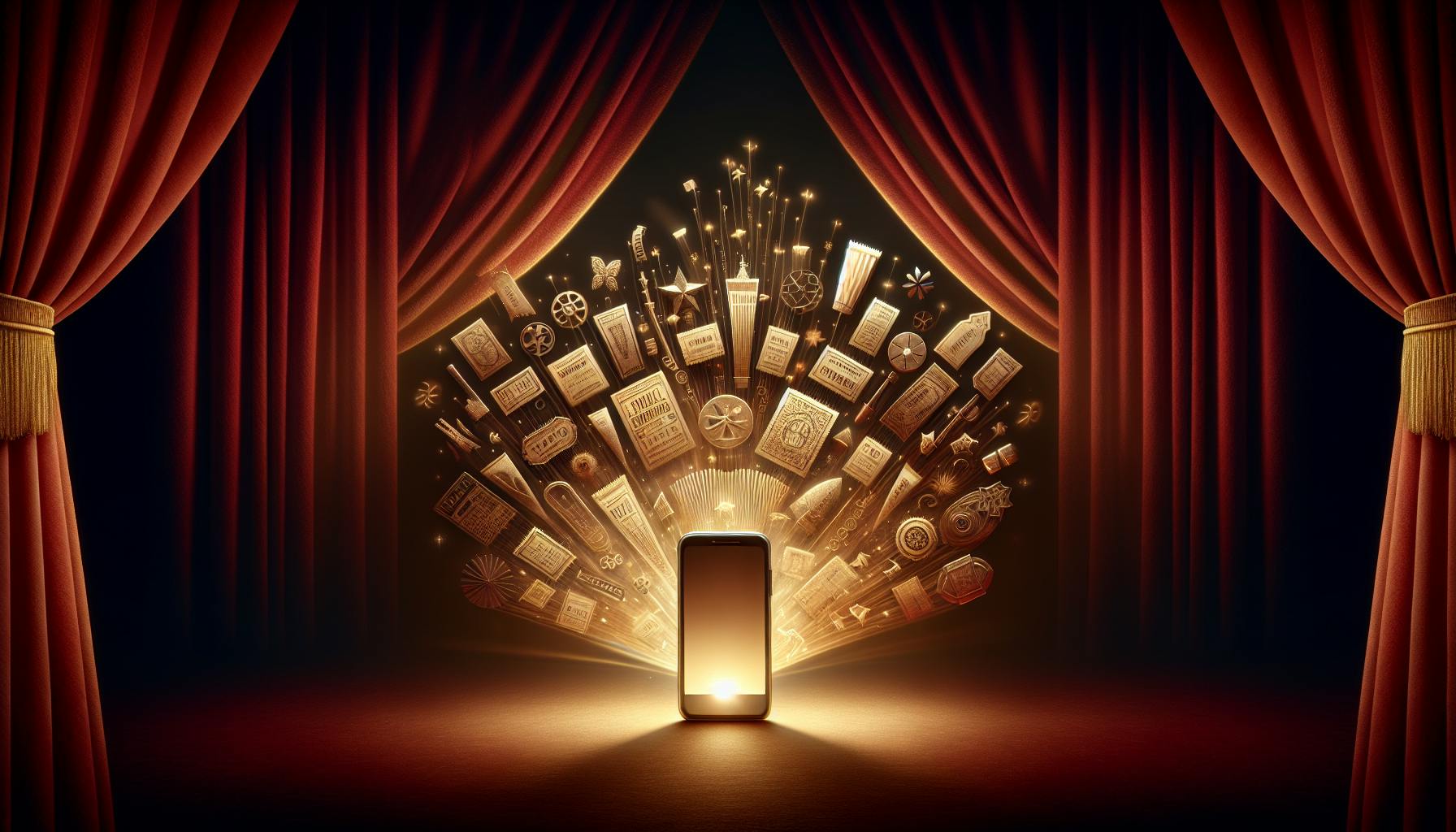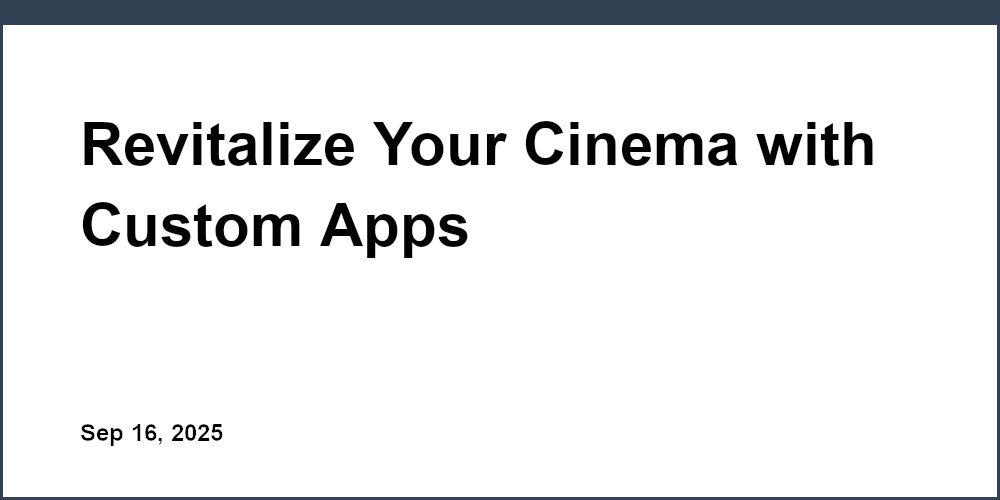Creating an engaging online experience is crucial for movie theaters in today's digital world.
By optimizing website design for user experience, theaters can provide seamless navigation, quick load times, and compelling layouts to draw in visitors and drive sales.
This article will detail best practices for movie theater websites, from streamlining user journeys to showcasing engaging features like reviews and seat selection, helping theaters enhance engagement and connect with online audiences.
Introduction to Movie Theater Website Design
A movie theater's website design plays a crucial role in enhancing the user experience to drive ticket sales and customer loyalty. As movie theaters transition from traditional advertising to digital platforms, their website serves as the cornerstone of their online identity and interactions with customers. An effectively designed website can positively influence customer behavior and satisfaction.
The Evolution of Movie Theater Web Presence
In the past, movie theaters relied heavily on print media, radio, and television to promote upcoming movie releases and theater events. As consumer behavior shifted towards online and mobile platforms, movie theaters adapted by establishing their own websites. These early theater websites provided basic information like showtimes, ticket prices, location maps, and contact details.
Over time, movie theaters realized the untapped potential of their websites for attracting and engaging customers. Modern theater websites now incorporate vivid imagery, video trailers, responsive design, seamless booking systems, and integrated social media. They enable personalized experiences through loyalty programs and tailored content recommendations. A theater's website design directly impacts vital metrics like monthly visitors, newsletter signups, and online ticket purchases.
The Impact of User Experience on Theater Success
An intuitive, user-friendly website enhances customer satisfaction and encourages repeat visits. Simple, well-organized navigation allows visitors to easily find showtimes and quickly complete purchases. Optimized page load speeds prevent visitors from abandoning the site due to delays. Responsiveness across devices delivers a seamless experience regardless of screen size.
Accessible design choices help accommodate all potential moviegoers. Clear calls-to-action guide users to intended goals like ticket sales or newsletter subscriptions. A visually appealing design immerses visitors into the theater's unique brand identity. Personalized content and loyalty features help foster lasting connections with customers.
By focusing efforts on crafting an exceptional user experience, movie theaters can drive higher online conversions and revenue. An optimized website serves as the theater's most effective digital marketing asset for acquiring and retaining loyal moviegoers.
Designing for a Seamless User Journey
Creating a seamless user experience should be a top priority when designing a movie theater website. An intuitive site navigation, fast page loads, and accessibility features allow visitors to easily find showtimes, purchase tickets, and access theater information.
Streamlining Navigation for Ease of Use
- Organize content using simple main menus, filtering tools, and site search to help visitors quickly find desired information. For example, allow visitors to browse movies by genre or filter showtimes by date, time, and location.
- Ensure menu items and calls-to-action are clearly visible. Key pages like Showtimes, Membership Signup, and Gift Cards should be linked from both the main navigation menu and homepage.
- Use breadcrumb trails below page titles to display a visitor's location within the site architecture. This allows easy navigation to higher-level pages.
- Implement responsive design so navigation menus adapt across desktop, tablet, and mobile devices. Hamburger menus effectively consolidate navigation elements on mobile.
Integrating Search Functionality
An effective site search is vital for locating specific content. Consider the following best practices:
- Allow visitors to search movies, showtimes, theater locations, membership information, and site content through one search box.
- Offer typeahead search suggestions and corrections for misspellings or unfinished queries.
- Display search results clearly, highlighting the most relevant pages first. Let visitors refine results through tools like filters and facets.
Optimizing for Quick Load Times
Slow page speeds lead to high bounce rates. Use these techniques to maximize performance:
- Compress images and enable browser caching to reduce page weight and repeat download times.
- Minify CSS, JavaScript, and HTML files to eliminate unnecessary code bulk.
- Use a content delivery network (CDN) to distribute assets globally and serve them from the closest servers.
- Set performance budgets and regularly test site speed on various devices to meet page load benchmarks.
Ensuring Accessibility for All Users
Accessible design provides experiences usable by people with disabilities:
- Allow text scaling and color contrast adjustments for low vision visitors.
- Add ARIA attributes for screen readers to effectively convey page structure and function.
- Design buttons and forms usable without a mouse through keyboard shortcuts and tab flows.
- Provide closed captioning for trailers and other video content.
Following web accessibility standards opens your content to more potential customers and also meets legal requirements for ADA compliance.
Creating Visually Compelling Layouts
Movie theater websites need to balance visual appeal with ease of use to create great user experiences. Here are some tips:
Balancing Visual Elements with Functionality
A visually striking movie theater website can draw visitors in, but too many flashy elements can make it hard to find information or buy tickets.
- Use high-quality photos and videos, but don't let them slow page load times. Optimize media files.
- Limit slideshows and carousels. They look nice, but users want the info up front.
- Ensure vital info and calls-to-action are visible above the fold so users don't have to scroll to find them.
Keep site navigation simple and consistent across pages so users can easily find what they need.
Utilizing High-Quality Media Content
Engaging visuals that match a movie theater's brand can capture attention and highlight current and upcoming films.
- Display trailers, behind-the-scenes footage, actor interviews and more to generate excitement.
- Feature high-res photos of lobby displays, theaters, and concessions to convey an immersive experience.
- Spotlight specialty menus and events with enticing food and drink photos.
Curate media galleries to promote specific movies or theater offerings.
Adapting to Various Screen Sizes
With so many visitors accessing sites via mobile devices, a responsive design is essential.
- Use flexible layouts and fluid images that automatically resize.
- Ensure buttons and links are tap-friendly for touchscreens.
- Check site performance across different devices during development.
Optimizing for smaller screens makes navigation faster and easier for all users. The focus remains on displaying engaging content in a functional, accessible way.
sbb-itb-b1b0647
Incorporating Features for Enhanced Engagement
Movie theater websites can incorporate various features to increase user engagement and encourage repeat visits from moviegoers.
Showcasing User Reviews and Ratings
Integrating user-generated content like reviews and ratings on movie theater websites builds trust and fosters a sense of community. Displaying authentic feedback and ratings from local moviegoers who have attended the theater provides social proof of quality. This transparency helps visitors make informed decisions about which movies to watch.
Reviews can be incorporated through third-party platforms like Yelp or native review systems. Ratings can be displayed through a 5-star system. Moderation and sentiment analysis should be used to filter out toxic comments. Overall, user-generated content adds tremendous value for potential customers researching their movie options.
Personalizing User Experiences
Using personalization techniques tailored to individual users enhances engagement significantly. For example, movie suggestions can be provided based on past behavior and preferences. Personalized recommendations make visitors feel valued.
Other personalization tactics include:
- Customized homepage content for logged-in users
- Targeted notifications about new movies in their watchlist
- Location-based showtime recommendations
- Email/push notification alerts for upcoming releases in favorite genres
The more relevant the experience, the higher the chance of converting site visitors into ticket buyers.
Implementing Interactive Seat Selection
An interactive seat map that allows customers to select their actual seats when booking tickets online is extremely beneficial. This transparency allows pickier moviegoers to secure their preferred spots in the theater ahead of time.
Features like visual indicators showing occupied/available seats and aisle views bolster confidence during selection. Integrated dynamic pricing can charge premiums for the best seats. Overall, interactive seating charts enhance user experience and provide theaters more pricing flexibility.
Offering Real-Time Chat Support
Having instant access to help when needed is pivotal for positive user experience. A real-time chat system lets visitors get answers to any questions that arise while browsing the movie theater's website.
Chatbots can provide basic support, while human agents should be available to handle complex inquiries. Fast, personalized assistance increases trust and likelihood of conversion. Chat is also useful for capturing visitor data to inform marketing and customer service strategies.
Leveraging Best Practices from Top Theater Websites
Analyzing the strategies used by industry-leading theatre websites can provide valuable insights for other movie theaters looking to enhance their online presence. By examining what works well and adapting these best practices, theaters can create exceptional experiences for their users.
Learning from Industry Leaders
The best theatre websites stand out through thoughtful design that prioritizes usability and the user experience. Key elements that other websites can emulate include:
- Intuitive navigation: Making key pages easy to find, with menus tailored to user goals. Dropdown menus, breadcrumb trails and site search help users quickly access desired content.
- Mobile responsiveness: Adapting layouts for seamless mobile access, with tap targets, minimized scrolling and fast load times. This meets rising demand for on-the-go ticket purchases.
- Accessibility features: Alt text for images, color contrast, keyboard shortcuts and ARIA markup enhance access for those with disabilities. This shows a commitment to inclusion.
By studying top industry examples, theatres can apply learnings to their own sites in impactful ways.
Innovations in Online Ticketing and Reservations
Leading theatre websites make online ticket purchasing seamless through innovations like:
- Interactive seat maps: Visual interfaces allowing ticket-buyers to select their exact seats in context. This reduces confusion and improves satisfaction.
- Streamlined checkout: Saving user details for express checkouts via one-click payments or wallet integrations. This dramatically improves conversion rates.
- Targeted upselling: Dynamic offers for add-ons like premium formats and concessions based on showtime or seating. Personalization drives higher revenue.
Prioritizing ticketing and reservation UX delivers tangible business impact for theatres through increased online sales.
Effective Use of Branding and Storytelling
Unique branding and emotive storytelling set leading theatre websites apart by forging lasting connections with audiences. Tactics include:
- Showcasing historical significance: Weaving the theatre’s heritage and place in the community into copy and visuals. This builds affinity with local moviegoers.
- Behind-the-scenes content: Photos, videos and blogs on cinema operations humanize the brand. Piquing interest drives loyalty and engagement.
- Promoting special events: Sections highlighting film festivals, sing-alongs, Q&As and more make the theatre a cultural destination. Driving awareness sells more tickets.
Leveraging online platforms as storytelling mediums strengthens branding and deepens audience relationships over time.
By benchmarking the most effective strategies used by top theatre websites, movie theaters can elevate their own online presence to drive sales, engagement and loyalty. Prioritizing core elements like usability, innovation and storytelling lays the groundwork for success.
Conclusion: Summarizing the Blueprint for Success
An exceptional movie theater website design focused on user experience is key to achieving better business outcomes. Here's a summary of the key points:
- Navigation: Make it easy for visitors to find showtimes, book tickets, and access account information. Clear menus, intuitive flows, and smart search help users quickly accomplish tasks.
- Speed: Fast load times keep visitors engaged. Optimize images, minify code, and leverage caching to deliver quick page loads.
- Accessibility: Ensure your site works well for all visitors through standards compliance, alt text for images, color contrast, and more.
- Responsive Design: Adapt to any device. Mobile-friendly and fully responsive sites engage users everywhere.
- Personalization: Use data and testing to tailor content to individual visitors. Personalized experiences drive conversion lift.
By focusing on exceptional user experience enabled by strategic website design choices, movie theaters can sell more tickets, strengthen loyalty, improve retention and provide outstanding customer service. The result is higher revenue and a stronger brand reputation over the long-term.


